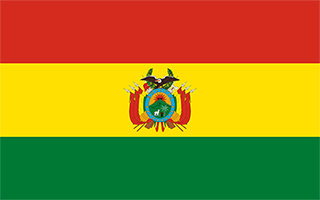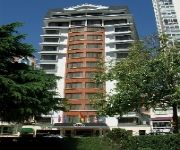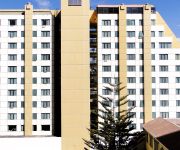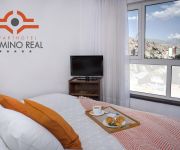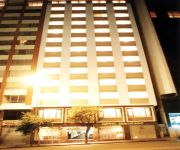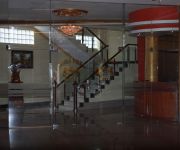Safety Score: 3,2 of 5.0 based on data from 9 authorites. Meaning please reconsider your need to travel to Bolivia.
Travel warnings are updated daily. Source: Travel Warning Bolivia. Last Update: 2024-08-13 08:21:03
Delve into San Jorge
The district San Jorge of La Paz in Departamento de La Paz is a subburb in Bolivia about 257 mi north-west of Sucre, the country's capital town.
If you need a hotel, we compiled a list of available hotels close to the map centre further down the page.
While being here, you might want to pay a visit to some of the following locations: Coroico, Desaguadero, Zepita, Yunguyo and Guanay. To further explore this place, just scroll down and browse the available info.
Local weather forecast
Todays Local Weather Conditions & Forecast: 12°C / 54 °F
| Morning Temperature | 8°C / 46 °F |
| Evening Temperature | 11°C / 51 °F |
| Night Temperature | 7°C / 45 °F |
| Chance of rainfall | 2% |
| Air Humidity | 54% |
| Air Pressure | 1012 hPa |
| Wind Speed | Moderate breeze with 10 km/h (6 mph) from South-West |
| Cloud Conditions | Overcast clouds, covering 95% of sky |
| General Conditions | Light rain |
Monday, 18th of November 2024
11°C (51 °F)
7°C (44 °F)
Moderate rain, gentle breeze, overcast clouds.
Tuesday, 19th of November 2024
12°C (53 °F)
7°C (44 °F)
Light rain, gentle breeze, overcast clouds.
Wednesday, 20th of November 2024
12°C (53 °F)
8°C (46 °F)
Light rain, moderate breeze, overcast clouds.
Hotels and Places to Stay
Ritz Apart Hotel
Hotel Europa CONNECT
Stannum Boutique Hotel
Camino Real Aparthotel & Spa
Hotel Europa La Paz
ELDORADO HOTEL - LA PAZ
Hotel A La Maison
Golden Palace Hotel
Casa Prado
Panamerican Hotel
Videos from this area
These are videos related to the place based on their proximity to this place.
Videos provided by Youtube are under the copyright of their owners.
Attractions and noteworthy things
Distances are based on the centre of the city/town and sightseeing location. This list contains brief abstracts about monuments, holiday activities, national parcs, museums, organisations and more from the area as well as interesting facts about the region itself. Where available, you'll find the corresponding homepage. Otherwise the related wikipedia article.
La Paz
Nuestra Señora de La Paz (English: Our Lady of Peace; Aymara: Chuquiago Marka or Chuqiyapu) is the seat of government of Bolivia, as well as the departmental capital of the La Paz Department, and the second largest city in the country (in population) after Santa Cruz de la Sierra.
Estadio Hernando Siles
Estadio Hernando Siles is a sports stadium in La Paz, Bolivia. It is the country's largest sports complex with a capacity of 42,000 seated spectators and is named after Hernando Siles Reyes, the 31st President of Bolivia (1926–1930). The stadium is located in the Miraflores borough of La Paz, at an altitude of 3,637 metres (11,932 feet) above sea level, making it one of the highest professional stadiums in the world.
Pedro Domingo Murillo Province
Pedro Domingo Murillo is a province in the Bolivian La Paz Department. It was created on January 8, 1838, with the name Cercado and on October 17, 1912, during the presidency of Eliodoro Villazón, its name was changed in honor of Pedro Domingo Murillo, protagonist of the revolution of June 16, 1809. The province contains the Bolivian administrative capital, La Paz, as well as the major city of El Alto.
El Alto International Airport
El Alto International Airport (Spanish: Aeropuerto Internacional El Alto) is an international airport located 8 mi south west of La Paz, La Paz Department, Bolivia. The airport is located in the city of El Alto and has served since the first half of the 20th century, but was modernized in the late 1960s, when its runway was lengthened and a new passenger terminal with modern facilities was built. The new airport was inaugurated in 1965.
El Alto, La Paz
El Alto, La Paz File:Altiplano de La Paz Bolivia.
Estadio Rafael Mendoza
Estadio Rafael Mendoza Castellón is a multi-use stadium in the neighborhood of Achumani, La Paz, Bolivia. It is currently used mostly for football matches and belongs to the "Club The Strongest" The stadium has a capacity of 15,000 people.
Palacio Quemado
The Palacio Quemado is a popular name to denote the Bolivian Palace of Government, located on Plaza Murillo in downtown La Paz. It is the official residence of the President of Bolivia. The building has had many incarnations. Its nickname ("Palacio Quemado," or "Burned Palace") originates from the fact that it was set aflame and burned almost to the ground during an uprising in 1875. It has since been rebuilt and revamped a number of times, but the name stuck.
Estadio Libertador Simón Bolívar
Estadio Libertador Simón Bolivar is a multi-use stadium in the Tembladerani neighborhood of the city of La Paz, Bolivia. It is most often used for football matches, on club level by Club Bolívar. The stadium has a capacity of 25,000 people.
Metro La Paz
Metro La Paz is located on the west side of Bolivia, with a population of more than 2.3 million inhabitants joining the cities of La Paz, El Alto,and Viacha, it is the most populous urban area of Bolivia. At an altitude that can reach more than of 4,000 meters above the sea level, it is the highest metropolitan city in the world.
Central Bank of Bolivia
The Central Bank of Bolivia (Spanish: Banco Central de Bolivia) is the central bank of Bolivia, responsible for monetary policy and the issuance of banknotes. The current president of the BCB is Marcelo Zabalaga Estrada. The official site is http://www. bcb. gob. bo.
San Pedro prison
San Pedro prison or El penal de San Pedro is the largest prison in La Paz, Bolivia renowned for being a society within itself. Significantly different from most correctional facilities, inmates at San Pedro have jobs inside the community, buy or rent their accommodation, and often live with their families. The sale of cocaine base to visiting tourists gives those inside a significant income and an unusual amount of freedom within the prison walls.
Valle de la Luna (Bolivia)
Valle de la Luna (moon valley in English) is situated about 10 kilometers from downtown La Paz, in the Pedro Domingo Murillo Province, La Paz Department, Bolivia. It is composed of an area where erosion has worn away the majority of a mountain. Due to being composed of clay rather than rock, over the centuries the elements have created a somewhat odd work of art here, like a desert filled with stalagmites.
Neo-Tiwanakan architecture
The Neo-Tiwanakan or Pseudo-Tiwanakan architecture is a style developed by the architect Emilio Villanueva Peñaranda between the years 1930 and 1948 inspired in the designs of the Pre-Columbian archeological site of Tiwanaku in Bolivia.
1582 Ancuancu earthquake
On April 2, 1582 Ancuancu was struck by an earthquake, that reportedly buried its inhabitants. On the place were the village had stood, the Jacha Kalla (Achocalla) valley was formed as a result of the earthquake.
Plaza Murillo
The Plaza Murillo is the central plaza of the city of La Paz and the open space most connected to the political life of Bolivia. Prominent buildings on the plaza include the Presidential Palace, National Congress of Bolivia, and the Cathedral of La Paz. It is located in the old town, or Casco Viejo, of the city and is surrounded by Socabaya Street to the west, Ayacucho Street to the east, Comercio Street to the south, and a continuation of Ingavi and Ballivan Streets to the north.
Paqu Quta
Paqu Quta, also spelled P'aqu Quta, (Aymara paqu / p'aqu light brown, reddish, fair-haired, dark chestnut, quta lake, "chestnut coloured lake") is a lake in Bolivia located in the La Paz Department, Pedro Domingo Murillo Province, El Alto Municipality. It is situated at a height of about 4,667 metres (15,312 ft) south of Mount Chacaltaya, south east of Lake Milluni and south west of Qillwani (Khelluani).
Laram Quta (Pedro Domingo Murillo)
Laram Quta (Aymara larama blue, quta lake, "blue lake", hispanicized spelling Laram Kkota) is a lake in Bolivia located in the La Paz Department, Pedro Domingo Murillo Province, El Alto Municipality. It lies south of Mount Chacaltaya, south east of Lake Milluni and north west of Qillwani (Khelluani). Laram Quta is situated at a height of about 4,556 metres (14,948 ft), about 0,5 km long and 0,17 km at its widest point.
Embassy of Colombia, La Paz
The Embassy of Colombia in La Paz is the diplomatic mission of the Republic of Colombia to the Plurinational State of Bolivia; it is headed by the Ambassador of Colombia to Bolivia, and it is located in the Calacoto neighbourhood of La Paz, precisely at Calle Roberto Prudencio 797, between calles 15th and 16th.
Jach'a Quta (Murillo)
Jach'a Quta (Aymara jach'a big, great, quta lake, "great lake", hispanicized spelling Jacha Kkota) is a lake in Bolivia located in the La Paz Department, Pedro Domingo Murillo Province, Achocalla Municipality. It is situated south of El Alto and La Paz near Achocalla. Jach'a Quta is situated at a height of about 3,760 metres (12,340 ft), about 0.67 km long and 0.5 km at its widest point.
The Triplets bridges
Three consecutive Extradosed bridges are part of a north beltway of La Paz in Bolivia. The project was funded by CAF (Corporación Andina de Fomento) through a credit to the Municipality in 2006. In 2007 the Municipal Government of La Paz awarded the design and construction of The Triplets Bridge Project to the JV “Consorcio Asociación Accidental Progreso”. As part of this contract, PEDELTA carried out the conceptual and final detailed design.
Sirk'i Quta
Sirk'i Quta (Aymara sirk'i wart, quta lake, hispanicized spellings Serkhe Khota, Serkhe Kkota) is a lake in Bolivia located in the La Paz Department, Pedro Domingo Murillo Province, La Paz Municipality, south of the Qutapata National Park It lies between the Inkachaka Lake in the west and the mountain Sirk'i Qullu in the east. Sirk'i Quta is situated at a height of about 4,814 metres (15,794 ft), 0.73 km long and 0.28 km at its widest point.
